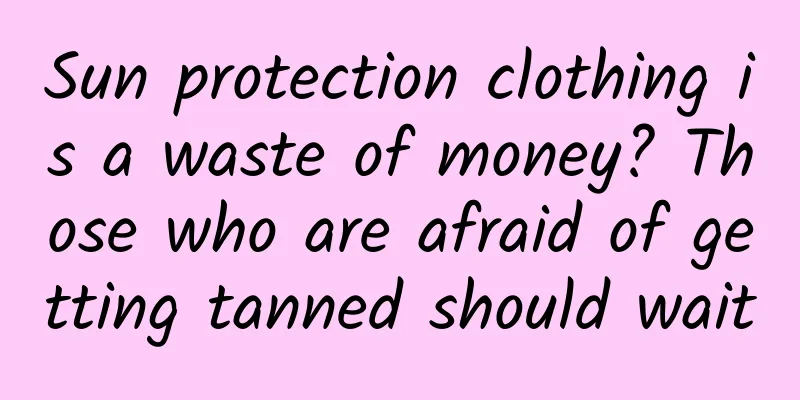Sun protection clothing is a waste of money? Those who are afraid of getting tanned should wait

|
gossip The weather is getting hotter and hotter, and the sun is getting bigger. During the May Day holiday, beauty-conscious people not only apply sunscreen, but also wear sun-protective clothing. However, some people would say that wearing a long-sleeved jacket can protect against the sun, and sun-protective clothing is just an IQ tax. In fact, compared with ordinary clothes, sun protection clothing has better sun protection effect. analyze Why can clothing protect against the sun? Clothing plays an important role in protecting the human body from UV damage. The fabrics of clothing we wear daily actually have a certain UV protection function. When ultraviolet rays hit the surface of clothing, reflection, scattering, absorption, and penetration will occur, so that the damage to the human skin surface will be reduced. The UV protection effect of clothing fabrics is closely related to factors such as fiber material, weaving structure tightness, fabric thickness, color depth, etc. For example, among natural fibers, cotton and silk have average UV protection effect, wool is slightly better, linen is the best, and among chemical fibers, polyester (also known as polyester fiber) has the best UV protection effect; the tighter the weaving structure of the fabric, the thicker it is, and the lower the porosity, the better the UV protection effect. However, everyday clothing has limited protection against UV rays. If we are exposed to strong sunlight for a long time, we need sun-protective clothing with higher UV protection capabilities. Image source: Copyright Library Specialized sun protection clothing can reduce the amount of ultraviolet rays that pass through the fabric and reach the skin surface by improving the reflection, scattering or absorption of ultraviolet rays. How does sun protection clothing protect against the sun? Sun protection clothing fabrics generally follow two principles to achieve sun protection function: ① Shielding principle: Enhance the reflection and scattering effect of fabrics on ultraviolet rays, such as applying a shielding agent coating on the inner layer of the fabric, or adding a shielding agent to the fibers of the fabric; ②Absorption principle: Enhance the fabric's absorption of ultraviolet rays, convert the energy after ultraviolet rays absorption into heat release or harmless low-energy radiation. For example, when dyeing the fabric, choose dyes that absorb ultraviolet rays better, or apply anti-ultraviolet absorber coating to the fabric. So, what level of sun protection is required to be called sun-protective clothing? According to the national standard GB/T 18830-2009 "Evaluation of UV Protection Performance of Textiles", UV protection textiles must reach UPF>40 and UVA transmittance <5% to be called UV protection products. The ultraviolet protection factor (UPF) refers to the ratio of the average effect of ultraviolet radiation calculated when the skin is unprotected to the average effect of ultraviolet radiation calculated when the skin is protected by fabric. The larger the UPF value, the better the UV protection performance of the textile. UVA is the part with the longest wavelength in ultraviolet rays, with strong penetrating power, which can directly reach the dermis of the skin and destroy elastic fibers and collagen fibers. The smaller the UVA transmittance, the better the UV protection performance of the textile. Image source: Copyright Library Expensive sun protection clothing Is it really a tax on IQ? Fortunately, people are now more aware of sun protection, and many people will buy sun protection clothing. But with prices ranging from tens to thousands, how should we choose? In fact, we just need to identify a logo and then consider the selling price comprehensively, and we can get it done. According to the national standard GB/T 18830-2009 "Evaluation of UV protection performance of textiles", UV protection products should be clearly marked on the products, and the marking content must include the following parts: ——The standard number, i.e. GB/T 18830-2009; ——When 40<UPF≤50, it is marked as UPF40+. When UPF>50, it is marked as UPF50+; - The protection provided by this product may be reduced under prolonged use and when stretched or wet. Sun-protective clothing that meets national standards must have the above logo, which is also the most direct basis for consumers when purchasing sun-protective clothing. So, how expensive is a sun protection clothing? In fact, considering the overall cost of fabrics, design and craftsmanship, sun protection clothing that costs more than 100 yuan and has the above logo can be purchased with confidence, and sun protection clothing that is too cheap is not recommended. Some sun protection clothing is very expensive, and a large part of it includes factors such as brand premium and design style. Under the condition of meeting the national standards, their UV protection function for the skin is not much different. However, we may also have a feeling that even if we buy a brand-name sun protection clothing, it is still a bit stuffy when we wear it. Why is this? In fact, this is mainly determined by the materials and craftsmanship, and the designers have actually put a lot of effort into it. Sun protection clothing How can I breathe more? Image source: Copyright Library At present, the most common fabric for sun-protective clothing on the market is polyester (also known as polyester fiber), followed by nylon, or fabrics woven from polyester and nylon. A small amount of spandex is usually added to increase the elasticity of the fabric and enhance the comfort of wearing. Polyester and nylon are the two most common chemical fibers. They both have outstanding mechanical properties. The woven fabrics have high tensile strength and good wear resistance, and are widely used in the production of outdoor protective clothing. Polyester fabrics themselves have outstanding UV protection capabilities; in addition, various anti-UV treatment technologies for polyester are very mature, and they have strong moisture absorption and perspiration capabilities, making polyester the preferred material for the production of sun-protective clothing. Nylon has strong moisture absorption and perspiration capabilities, a large thermal conductivity, and can provide a relatively obvious instantaneous cool feeling when touched, and is also widely used in sun-protective clothing. Sun protection clothing usually uses a tighter weaving structure, because the tighter the fabric structure, the less UV light can penetrate. Generally speaking, the structure of woven fabrics is tighter than that of knitted fabrics. The tight fabric structure and the fact that many sun protection clothing use fabric coating to improve UV protection will reduce the air permeability of the fabric. Many sun protection clothing also use knitted fabrics, which are more breathable than woven fabrics. In addition, some technical processing is also used in the design of sun-protective clothing to increase breathability. For example, mesh fabrics are used in areas such as the armpits and the bottom of the sleeves that are not exposed to direct sunlight. Some sun-protective clothing is designed as a wide shawl style, which increases the air layer between the sun-protective clothing and the body, which helps the body dissipate heat when exercising and reduces the feeling of stuffiness. When choosing sun-protective clothing, it is recommended to choose sun-protective clothing with cool-colored fabrics; when washing sun-protective clothing, try to wash it gently by hand to avoid rubbing it hard to destroy the sun-protective effect of the fabric or causing the fabric structure to loosen. If the sun-protective clothing becomes obviously light-transmissive and the fabric structure becomes loose after a period of use, it should be replaced with a new one. in conclusion Everyday clothing has limited protection against UV rays. If we are exposed to strong sunlight for a long time, we need sun-protective clothing with higher UV protection capabilities. Specialized sun protection clothing can reduce the amount of ultraviolet rays that pass through the fabric and reach the skin surface by improving the reflection, scattering or absorption of ultraviolet rays. References: [1] Gu Jianmei. National Health Safety Knowledge Series: Cosmetic Safety Knowledge Reader[M]. 2017 [2] Di Hongjing, Wang Haiguang, Li Jie. Research on the evaluation of UV protection performance and wearing comfort of sun protection clothing[J]. China Fiber Inspection, 2021(08):70-73.DOI:10.14162/j.cnki.11-4772/t.2021.08.020 [3] Yang Huijuan. Research and design experiment of sunscreen functional clothing[D]. Donghua University, 2014. [4] National Standard GB/T 18830-2009 “Evaluation of UV Protection Performance of Textiles” Author: Song Lidan, Consulting Engineer, Industrial Research Department, China Textile Construction Planning Institute Review|Zhang Jie, Chief Engineer of China Textile Construction Planning Institute Editor | Ding Zong The article is produced by "Science Refutes Facts" (ID: Science_Facts). Please indicate the source when reprinting. The pictures in this article are from the copyright gallery and are not authorized for reproduction. |
>>: Early screening methods for 7 common cancers, 99% of people regret knowing it too late!
Recommend
Are fluffy powder and wash-free spray the magic weapon to save oily-haired girls? Doctor: Don't use them, you'll go bald
"I found that the only thing that I have not...
Putting smart "environmental protection bracelet" on excavators? Reducing pollution and carbon emissions, Beidou shows its power!
Recently, the Shandong Environmental Science Soci...
What exactly is the “Arctic Catfish”?
The "Arctic Catfish" incident has come ...
Changes in the traffic market in 2020
2020 is a very unforgettable year in the hearts o...
Outlook for brand marketing trends in 2022!
During the epidemic, "growth" is less e...
Men's Health Day丨Care for men's health, how to stay away from the pain of "inflammation"?
Author: Wu Zhigang, deputy chief physician, First...
What are the opening lines and techniques for live streaming sales on Douyin? Tik Tok live broadcast script
This article mainly introduces the opening remark...
How does this magical building come with the “warm in winter and cool in summer buff”?
There is a kind of building that can be warm in w...
2500 words user retention analysis
Faced with the current situation of difficulty in...
Here are seven key points about APP message push
So, how to build a good APP message push mechanis...
Let’s go! Let’s eat Sichuan cuisine
Sichuan There are countless mountain valleys Ther...
A senior product operations manager teaches you: How to make a good version analysis report?
In product development, only the development team...
Why is Mango TV always the one that eats crabs?
At a time when Internet thinking has become a pop...
Sina Micro Wealth's Rapid March: A Subversive Game for Latecomers
It seems that overnight, those who used to check ...
It is said online that constipation can cause colorectal cancer. Is this true?
When it comes to constipation, many people have t...









